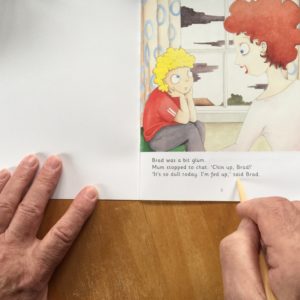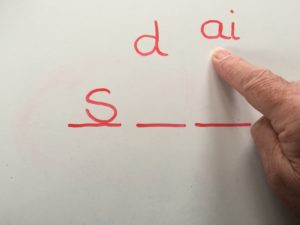A question I’m often asked by both parents and teachers is what you do when the child you’re working with comes up against a word that has in it a sound-spelling correspondence (SSC) you haven’t yet covered.
Here’s what to do.
Supposing you’ve covered the (SSCs) [a] [i] [m] [s] [t] [n] [o] [p] [b] [c] [g] [h] [d] [e] [f] [v]. This is a little bit of a random list but it will do for the purposes for which I want to demonstrate.
So, the child in question is also able to segment and blend all of the above SSCs and they are able to connect sound to spelling and spelling to sound. They can, therefore, already read dozens of words like ‘bag’, ‘cod’, ‘van’, ‘fed’, ‘pit’, ‘vet’.
But what happens if, say, the word ‘wet’ comes up in the text. The child has already been taught the SSCs [e] and [t]. What they haven’t yet been taught is the spelling [w] for /w/. Rather than give the child the whole word, it’s much better if you point to the [w] and say to the child, “This is /w/. Say /w/ here.” The child should then have no difficulty in saying /w/ /e/ /t/, ‘wet’.
That is very straightforward. So, what do you do when the word is ‘said’, a very common word to have to read in many texts. In the example ‘said’, you should  just run your chopstick* under the spelling [ai] and, say, “This is two letters but it’s just one sound. It’s /e/. Say /e/ here.” And the child should say /s/ /e/ /d/, ‘said’.
just run your chopstick* under the spelling [ai] and, say, “This is two letters but it’s just one sound. It’s /e/. Say /e/ here.” And the child should say /s/ /e/ /d/, ‘said’.
That provides an immediate solution as you’re reading. However, if the word is ‘said’ and it’s coming up again and again in a variety of texts, it will be desirable for the child to add the spelling [ai] of the sound /e/ in the word to their growing repertoire.
One of the best ways of doing this is by ‘word building’ it.
To do this, you need three squares of paper. You need to write the SSCs individually one at a time on to the squares and to put them on to a whiteboard jumbled up and out of order. Because it represents only one sound, remember that the spelling [ai] goes on one square. (Top tip: don’t write the SSCs in the correct order because the child will very likely spot this and not then have any cognitive work to do.)
Now, you draw three lines on your whiteboard and you draw you finger slowly under the lines, stretching out the word ‘ssssssssed’, and you ask the child what sound they can hear when your finger is under the first line. Be careful not to segment the word for the child. The gesture and the spoken word should be in harmony.
You may need to repeat this a few times. The child should be able to tell you that the first sound in ‘said’ is /s/. Now ask the child which one of the three squares is /s/. This shouldn’t present a problem since the child is already familiar with the SSC [s] for /s/.
You now repeat the same thing, starting from the beginning: “What’s the next sound you hear in ‘said’. Tell me what you can hear when my finger is under this line, (pointing under the second line).” Again, you need to say the word, this time stretching out the /e/: ‘seeeeeeed’. And the child should say /e/.
Now you ask, “Which one is /e/?” Because the child already knows that [d] represents the sound /d/, they should point to the [ai] spelling. When they do, ask them to pull it down on to the line and to s ay /e/ as they do. If they don’t or they are looking hesitant, simply tell them. Point to the spelling [ai] and say, “It’s this one.”
ay /e/ as they do. If they don’t or they are looking hesitant, simply tell them. Point to the spelling [ai] and say, “It’s this one.”
Finally, you do exactly the same with the last sound so that you have the spellings [s] [ai] [d] sitting on the three lines.
The next thing to do is to ask the child to put their finger under the first SSC and to read the word by saying the sounds one at a time: /s/ /e/ d/ ‘said’.
Last of all, draw three lines on your whiteboard (or a piece of paper), keep
ing the SSCs clearly in view as the child writes the word, saying each sound as they write. When they’ve done that, they read the word sound by sound and say the word once more.
This is the kind of robust practice children need if they are to get into long-term memory this spelling of /e/.
If you have time and the inclination, you should also talk about the unusual spelling of /e/ and you can explain that the way we say the word has changed over time but that the spelling hasn’t changed. We used to say – and some people in some parts of the country still say – /s/ /ae/ /d/, to rhyme with ‘played’, but now most people say /s/ /e/ /d/.
These techniques are very useful in dealing with any word in which there is an SSC that has not yet been taught. Rather than give the child the whole word, you tell them what sound the unfamiliar spelling represents and then allow them to put together the sounds to ‘hear’ the word. This provides practice in segmenting and blending, too.
*I find chopsticks are really useful for pointing accurately at exactly what the particular focus is and it doesn’t leave a pencil line under the text.